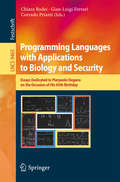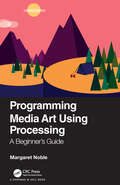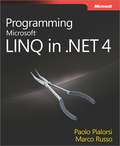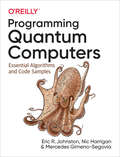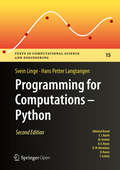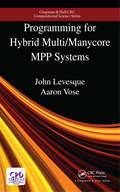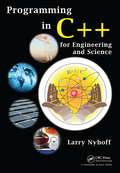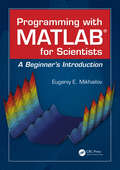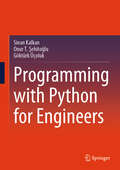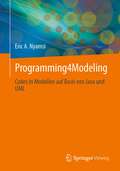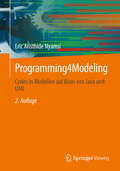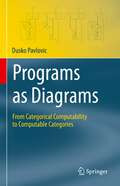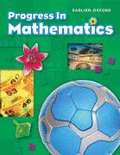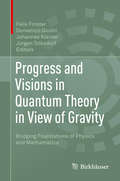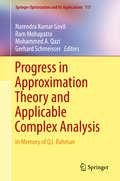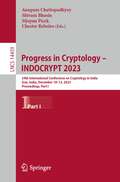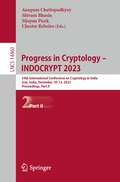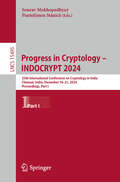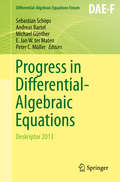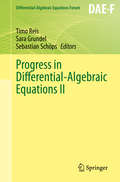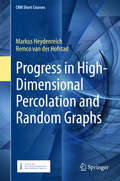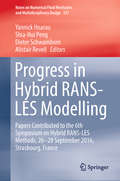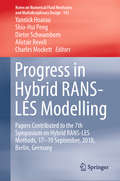- Table View
- List View
Programming Languages with Applications to Biology and Security
by Chiara Bodei Gian-Luigi Ferrari Corrado PriamiThis Festschrift volume is published in honor of Pierpaolo Degano on the occasion of his 65th birthday and is the outcome of a colloquium held in Pisa, Italy, in June 2015. Pierpaolo Degano has worked on a large variety of topics including formal program semantics, concurrency theory, systems biology and security. The volume contains 22 refereed papers and one extended abstract, including personal memoirs and regular research papers by close collaborators and friends and a laudatio illustrating his distinguished career and his main scientific contributions. The papers deal with the main research topics explored by Pierpaolo Degano and those still under his investigation.
Programming Media Art Using Processing: A Beginner's Guide
by Margaret NobleProgramming Media Art Using Processing: A Beginner's Guide provides an entry-level exploration into visual design through computer programming using the open source and artist-friendly language, Processing. Used by hundreds of students, this learning system breaks lessons down into strategic steps towards fun and creative media art projects. This book provides a linear series of lessons with step-by-step examples that lead to beginning media art projects, including abstract designs, pixel landscapes, rollover animations, and simple video games. Computer programming can be overwhelming for the first-time learner, but this book makes the learning of code more digestible and fun through a full color, well-diagrammed, and deeply explained text presentation. Lessons are rhythmically broken down into digestible parts with code annotations and illustrations that help learners focus on the details one step at a time. The content is legible, flexible, and fun to work with because of its project-based nature. By following the lessons and producing the projects sequentially in this book, readers will develop the beginning foundational skills needed to understand computer programming basics across many languages and also explore the art of graphic design. Ultimately, this is a hands-on, practical guide.
Programming Microsoft® LINQ in Microsoft .NET Framework 4
by Marco Russo Paolo PialorsiDig into LINQ -- and transform the way you work with data. With LINQ, you can query data from a variety of sources -- including databases, objects, and XML files -- directly from Microsoft Visual Basic® or C#. Guided by data-access experts who've worked in depth with LINQ and the Microsoft development teams, you'll learn how .NET Framework 4 implements LINQ, and how to exploit it. Clear examples show you how to deliver your own data-access solutions faster and with leaner code. Discover how to: Use LINQ to query databases, object collections, arrays, XML, Microsoft Excel® files, and other sources Apply LINQ best practices to build data-enabled .NET applications and services Manipulate data in a relational database with ADO.NET Entity Framework or LINQ to SQL Read, write, and manage XML content more efficiently with LINQ to XML Extend LINQ to support additional data sources by creating custom operators and providers Examine other implementations, such as LINQ to SharePoint® Use LINQ within the data, business, and service layers of a distributed application Get code samples on the Web
Programming Quantum Computers: Essential Algorithms and Code Samples
by Eric R. Johnston Nic Harrigan Mercedes Gimeno-SegoviaQuantum computers are poised to kick-start a new computing revolution—and you can join in right away. If you’re in software engineering, computer graphics, data science, or just an intrigued computerphile, this book provides a hands-on programmer’s guide to understanding quantum computing. Rather than labor through math and theory, you’ll work directly with examples that demonstrate this technology’s unique capabilities.Quantum computing specialists Eric Johnston, Nic Harrigan, and Mercedes Gimeno-Segovia show you how to build the skills, tools, and intuition required to write quantum programs at the center of applications. You’ll understand what quantum computers can do and learn how to identify the types of problems they can solve.This book includes three multichapter sections:Programming for a QPU—Explore core concepts for programming quantum processing units, including how to describe and manipulate qubits and how to perform quantum teleportation.QPU Primitives—Learn algorithmic primitives and techniques, including amplitude amplification, the Quantum Fourier Transform, and phase estimation.QPU Applications—Investigate how QPU primitives are used to build existing applications, including quantum search techniques and Shor’s factoring algorithm.
Programming for Computations - MATLAB/Octave
by Svein Linge Hans Petter LangtangenThis book presentscomputer programming as a keymethod for solving mathematical problems. There are two versions of the book,one for MATLAB and onefor Python. The book wasinspired by the Springer bookTCSE 6: A Primer on Scientific Programming with Python (by Langtangen), but the style is more accessible andconcise, in keeping with the needs of engineering students. The book outlines the shortest possible path from no previous experience with programming to a set ofskills that allows the students to write simple programs for solving commonmathematical problems withnumerical methods in engineering and science courses. The emphasis is on generic algorithms, cleandesign of programs, use of functions, and automatic tests for verification.
Programming for Computations - Python: A Gentle Introduction to Numerical Simulations with Python 3.6 (Texts in Computational Science and Engineering #15)
by Svein Linge Hans Petter LangtangenThis book is published open access under a CC BY 4.0 license. This book presents computer programming as a key method for solving mathematical problems. This second edition of the well-received book has been extensively revised: All code is now written in Python version 3.6 (no longer version 2.7). In addition, the two first chapters of the previous edition have been extended and split up into five new chapters, thus expanding the introduction to programming from 50 to 150 pages. Throughout the book, the explanations provided are now more detailed, previous examples have been modified, and new sections, examples and exercises have been added. Also, a number of small errors have been corrected. The book was inspired by the Springer book TCSE 6: A Primer on Scientific Programming with Python (by Langtangen), but the style employed is more accessible and concise, in keeping with the needs of engineering students. The book outlines the shortest possible path from no previous experience with programming to a set of skills that allows students to write simple programs for solving common mathematical problems with numerical methods in the context of engineering and science courses. The emphasis is on generic algorithms, clean program design, the use of functions, and automatic tests for verification.
Programming for Hybrid Multi/Manycore MPP Systems (Chapman & Hall/CRC Computational Science)
by John Levesque Aaron Vose"Ask not what your compiler can do for you, ask what you can do for your compiler."--John Levesque, Director of Cray’s Supercomputing Centers of Excellence <P><P>The next decade of computationally intense computing lies with more powerful multi/manycore nodes where processors share a large memory space. These nodes will be the building block for systems that range from a single node workstation up to systems approaching the exaflop regime. The node itself will consist of 10’s to 100’s of MIMD (multiple instruction, multiple data) processing units with SIMD (single instruction, multiple data) parallel instructions. Since a standard, affordable memory architecture will not be able to supply the bandwidth required by these cores, new memory organizations will be introduced. These new node architectures will represent a significant challenge to application developers. <P><P>Programming for Hybrid Multi/Manycore MPP Systems attempts to briefly describe the current state-of-the-art in programming these systems, and proposes an approach for developing a performance-portable application that can effectively utilize all of these systems from a single application. The book starts with a strategy for optimizing an application for multi/manycore architectures. It then looks at the three typical architectures, covering their advantages and disadvantages. <P><P>The next section of the book explores the other important component of the target—the compiler. The compiler will ultimately convert the input language to executable code on the target, and the book explores how to make the compiler do what we want. The book then talks about gathering runtime statistics from running the application on the important problem sets previously discussed. <P><P>How best to utilize available memory bandwidth and virtualization is covered next, along with hybridization of a program. The last part of the book includes several major applications, and examines future hardware advancements and how the application developer may prepare for those advancements.
Programming in C++ for Engineering and Science
by Larry NyhoffDeveloped from the author's many years of teaching computing courses, Programming in C++ for Engineering and Science guides students in designing programs to solve real problems encountered in engineering and scientific applications. These problems include radioactive decay, pollution indexes, digital circuits, differential equations, Internet addr
Programming with MATLAB for Scientists: A Beginner’s Introduction
by Eugeniy E. Mikhailov<p>This book offers an introduction to the basics of MATLAB programming to scientists and engineers. The author leads with engaging examples to build a working knowledge, specifically geared to those with science and engineering backgrounds. The reader is empowered to model and simulate real systems, as well as present and analyze everyday data sets. In order to achieve those goals, the contents bypass excessive "under the hood" details, and instead gets right down to the essential, practical foundations for successful programming and modeling. Readers will benefit from the following features: <li>Teaches programming to scientists and engineers using a problem-based approach, leading with illustrative and interesting examples. <li>Emphasizes a hands-on approach, with "must know" information and minimal technical details. <li>Utilizes examples from science and engineering to showcase the application of learned concepts on real problems. <li>Showcases modeling of real systems, gradually advancing from simpler to more challenging problems. <li>Highlights the practical uses of data processing and analysis in everyday life.</li>
Programming with Python for Engineers
by Göktürk Üçoluk Sinan Kalkan Onur T. ŞehitoğluThis book introduces computing and programming with undergraduate engineering students in mind. It uses Python (Version 3) as the programming language, chosen for its simplicity, readability, wide applicability and large collection of libraries. After introducing engineering-related Python libraries, such as NumPy, Pandas, Matplotlib, Sci-kit, Programming with Python for Engineers shows how Python can be used to implement methods common in a wide spectrum of engineering-related problems drawn from (for example): design, control, decision-making, scheduling and planning. Important features of the book include the following: The book contains interactive content for illustration of important concepts, where the user can provide input and by clicking buttons, trace through the steps. Each chapter is also accessible as a Jupyter Notebook page and every code piece is executable. This allows the readers to run code examples in chapters immediately, to make changes and gain a better grasp of the concepts presented. The coverage of topics is complemented by illustrative examples and exercises. For instructors adopting the textbook, a solutions manual is provided at https://sites.google.com/springernature.com/extramaterial/lecturer-material.
Programming4Modeling: Codes in Modellen auf Basis von Java und UML
by Eric A. NyamsiDas Buch fokussiert auf objektorientierte Softwareentwicklung in Bezug auf das Konzept "Programming4Modeling" genannt "P4M". Es stellt zum einen die Analyse und Design für die Modellierung mit UML und zum anderen die Softwareentwicklung mit Java dar. Das Buch wirft folgende Fragen auf: Wie ist die Architektur eines Klassenmodells? Welche Codes ermöglichen eine effiziente Softwareentwicklung? Was sind die Schnittpunkte von Codes und Modellen?
Programming4Modeling: Codes in Modellen auf Basis von Java und UML
by Eric Aristhide NyamsiDas Buch fokussiert auf objektorientierte Softwareentwicklung in Bezug auf das Konzept „Programming4Modeling“ genannt „P4M“. Es stellt zum einen die Analyse und Design für die Modellierung mit UML und zum anderen die Softwareentwicklung mit Java dar. Das Buch wirft folgende Fragen auf: Wie ist die Architektur eines Klassenmodells? Welche Codes ermöglichen eine effiziente Softwareentwicklung? Was sind die Schnittpunkte von Codes und Modellen?
Programs as Diagrams: From Categorical Computability to Computable Categories (Theory and Applications of Computability)
by Dusko PavlovicIt is not always clear what computer programs mean in the various languages in which they can be written, yet a picture can be worth 1000 words, a diagram 1000 instructions. In this unique textbook/reference, programs are drawn as string diagrams in the language of categories, which display a universal syntax of mathematics (Computer scientists use them to analyze the program semantics; programmers to display the syntax of computations). Here, the string-diagrammatic depictions of computations are construed as programs in a single-instruction programming language. Such programs as diagrams show how functions are packed in boxes and tied by strings. Readers familiar with categories will learn about the foundations of computability; readers familiar with computability gain access to category theory. Additionally, readers familiar with both are offered many opportunities to improve the approach. Topics and features: Delivers a ‘crash’ diagram-based course in theory of computationUses single-instruction diagrammatic programming languageOffers a practical introduction into categories and string diagrams as computational toolsReveals how computability is programmability, rather than an ‘ether’ permeating computers Provides a categorical model of intensional computation is unique up to isomorphismServes as a stepping stone into research of computable categories In addition to its early chapters introducing computability for beginners, this flexible textbook/resource also contains both middle chapters that expand for suitability to a graduate course as well as final chapters opening up new research. Dusko Pavlovic is a professor at the Department of Information and Computer Sciences at the University of Hawaii at Manoa, and by courtesy at the Department of Mathematics and the College of Engineering. He completed this book as an Excellence Professor at Radboud University in Nijmegen, The Netherlands.
Progress In Mathematics: Grade 3
by Catherine D. Le Tourneau Rose A. McDonnell Anne V. Burrows*This textbook has been transcribed in UEB, formatted according to Braille textbook formats, proofread and corrected. <P><P>SADLIER-OXFORD Progress In Mathematics grade 3 student textbook.
Progress and Visions in Quantum Theory in View of Gravity: Bridging Foundations of Physics and Mathematics
by Felix Finster Johannes Kleiner Jürgen Tolksdorf Domenico GiuliniThis book focuses on a critical discussion of the status and prospects of current approaches in quantum mechanics and quantum field theory, in particular concerning gravity. It contains a carefully selected cross-section of lectures and discussions at the seventh conference “Progress and Visions in Quantum Theory in View of Gravity” which took place in fall 2018 at the Max Planck Institute for Mathematics in the Sciences in Leipzig.In contrast to usual proceeding volumes, instead of reporting on the most recent technical results, contributors were asked to discuss visions and new ideas in foundational physics, in particular concerning foundations of quantum field theory. A special focus has been put on the question of which physical principles of quantum (field) theory can be considered fundamental in view of gravity.The book is mainly addressed to mathematicians and physicists who are interested in fundamental questions of mathematical physics. It allows the reader to obtain a broad and up-to-date overview of a fascinating active research area.
Progress in Approximation Theory and Applicable Complex Analysis
by Gerhard Schmeisser Narendra Kumar Govil Ram Mohapatra Mohammed A. QaziCurrent and historical research methods in approximation theory are presented in this book beginning with the 1800s and following the evolution of approximation theory via the refinement and extension of classical methods and ending with recent techniques and methodologies. Graduate students, postdocs, and researchers in mathematics, specifically those working in the theory of functions, approximation theory, geometric function theory, and optimization will find new insights as well as a guide to advanced topics. The chapters in this book are grouped into four themes; the first, polynomials (Chapters 1 -8), includes inequalities for polynomials and rational functions, orthogonal polynomials, and location of zeros. The second, inequalities and extremal problems are discussed in Chapters 9 -13. The third, approximation of functions, involves the approximants being polynomials, rational functions, and other types of functions and are covered in Chapters 14 -19. The last theme, quadrature, cubature and applications, comprises the final three chapters and includes an article coauthored by Rahman. This volume serves as a memorial volume to commemorate the distinguished career of Qazi Ibadur Rahman (1934-2013) of the Universit#65533; de Montr#65533;al. Rahman was considered by his peers as one of the prominent experts in analytic theory of polynomials and entire functions. The novelty of his work lies in his profound abilities and skills in applying techniques from other areas of mathematics, such as optimization theory and variational principles, to obtain final answers to countless open problems.
Progress in Cryptology – INDOCRYPT 2023: 24th International Conference on Cryptology in India, Goa, India, December 10–13, 2023, Proceedings, Part I (Lecture Notes in Computer Science #14459)
by Chester Rebeiro Anupam Chattopadhyay Shivam Bhasin Stjepan PicekThe two-volume proceedings constitutes the refereed proceedings of the 24th International Conference on Progress in Cryptology, INDOCRYPT 2023, Goa, India, in December 2023. The 26 full papers were carefully reviewed and selected from 74 submissions. They are organized in topical sections as follows: Part One: Symmetric-key cryptography, Hash functions, Authenticated Encryption Modes; Elliptic curves, Zero-knowledge proof, Signatures; Attacks.Part Two: Secure computation, Algorithm hardness, Privacy; Post-quantum cryptography.
Progress in Cryptology – INDOCRYPT 2023: 24th International Conference on Cryptology in India, Goa, India, December 10–13, 2023, Proceedings, Part II (Lecture Notes in Computer Science #14460)
by Chester Rebeiro Anupam Chattopadhyay Shivam Bhasin Stjepan PicekThe two-volume proceedings constitutes the refereed proceedings of the 24th International Conference on Progress in Cryptology, INDOCRYPT 2023, Goa, India, in December 2023. The 26 full papers were carefully reviewed and selected from 74 submissions. They are organized in topical sections as follows: Part One: Symmetric-key cryptography, Hash functions, Authenticated Encryption Modes; Elliptic curves, Zero-knowledge proof, Signatures; Attacks. Part Two: Secure computation, Algorithm hardness, Privacy; Post-quantum cryptography.
Progress in Cryptology – INDOCRYPT 2024: 25th International Conference on Cryptology in India, Chennai, India, December 18–21, 2024, Proceedings, Part I (Lecture Notes in Computer Science #15495)
by Pantelimon Stănică Sourav MukhopadhyayThis 2-volume set LNCS 15495-15496 constitutes the refereed proceedings of the 25th International Conference on Cryptology in India, held in Chennai, India, during December 18–21, 2024. The 31 full papers presented in these proceedings were carefully reviewed and selected from 96 submissions. They are organized into these topical sections: Part I: Foundations; symmetric-key cryptography; cryptographic constructions; and quantum cryptography. Part II: Cryptanalysis; post-quantum cryptography; and blockchain and cloud computing.
Progress in Cryptology – INDOCRYPT 2024: 25th International Conference on Cryptology in India, Chennai, India, December 18–21, 2024, Proceedings, Part II (Lecture Notes in Computer Science #15496)
by Pantelimon Stănică Sourav MukhopadhyayThis 2-volume set LNCS 15495-15496 constitutes the refereed proceedings of the 25th International Conference on Cryptology in India, held in Chennai, India, during December 18–21, 2024. The 31 full papers presented in these proceedings were carefully reviewed and selected from 96 submissions. They are organized into these topical sections: Part I: Foundations; symmetric-key cryptography; cryptographic constructions; and quantum cryptography. Part II: Cryptanalysis; post-quantum cryptography; and blockchain and cloud computing.
Progress in Differential-Algebraic Equations
by Sebastian Schöps Andreas Bartel Michael Günther E. Jan W. ter Maten Peter C MüllerThis book contains the proceedings of the 8th Workshop on Coupled Descriptor Systems held March 2013 in the Castle of Eringerfeld, Geseke in the neighborhood of Paderborn, Germany. It examines the wide range of current research topics in descriptor systems, including mathematical modeling, index analysis, wellposedness of problems, stiffness and different time-scales, cosimulation and splitting methods and convergence analysis. In addition, the book also presents applications from the automotive and circuit industries that show that descriptor systems provide challenging problems from the point of view of both theory and practice. The book contains nine papers and is organized into three parts: control, simulation, and model order reduction. It will serve as an ideal resource for applied mathematicians and engineers, in particular those from mechanics and electromagnetics, who work with coupled differential equations.
Progress in Differential-Algebraic Equations II (Differential-Algebraic Equations Forum)
by Sebastian Schöps Timo Reis Sara GrundelThis book contains articles presented at the 9th Workshop on Differential-Algebraic Equations held in Paderborn, Germany, from 17–20 March 2019. The workshop brought together more than 40 mathematicians and engineers from various fields, such as numerical and functional analysis, control theory, mechanics and electromagnetic field theory. The participants focussed on the theoretical and numerical treatment of “descriptor” systems, i.e., differential-algebraic equations (DAEs).The book contains 14 contributions and is organized into four parts: mathematical analysis, numerics and model order reduction, control as well as applications. It is a useful resource for applied mathematicians with interest in recent developments in the field of differential algebraic equations but also for engineers, in particular those interested in modelling of constraint mechanical systems, thermal networks or electric circuits.
Progress in High-Dimensional Percolation and Random Graphs
by Remco van der Hofstad Markus HeydenreichThis text presents an engaging exposition of the active field of high-dimensional percolation that will likely provide an impetus for future work. With over 90 exercises designed to enhance the reader's understanding of the material, as well as many open problems, the book is aimed at graduate students and researchers who wish to enter the world of this rich topic. The text may also be useful in advanced courses and seminars, as well as for reference and individual study. Part I, consisting of 3 chapters, presents a general introduction to percolation, stating the main results, defining the central objects, and proving its main properties. No prior knowledge of percolation is assumed. Part II, consisting of Chapters 4-9, discusses mean-field critical behavior by describing the two main techniques used, namely, differential inequalities and the lace expansion. In Parts I and II, all results are proved, making this the first self-contained text discussing high-dime nsional percolation. Part III, consisting of Chapters 10-13, describes recent progress in high-dimensional percolation. Partial proofs and substantial overviews of how the proofs are obtained are given. In many of these results, the lace expansion and differential inequalities or their discrete analogues are central. Part IV, consisting of Chapters 14-16, features related models and further open problems, with a focus on the big picture.
Progress in Hybrid RANS-LES Modelling: Papers Contributed To The 5th Symposium On Hybrid Rans-les Methods, 19-21 March 2014, College Station, A&m University, Texas, Usa (Notes On Numerical Fluid Mechanics And Multidisciplinary Design Ser. #130)
by Shia-Hui Peng Dieter Schwamborn Yannick Hoarau Alistair RevellThis book reports on the latest developments in computational fluid dynamics and turbulence modeling, with a special emphasis on hybrid RANS-LES methods and their industrial applications. It gathers the proceedings of the Sixth Symposium on Hybrid RANS-LES Methods, held on September 26-28 in Strasbourg, France. The different chapters covers a wealth of topics such as flow control, aero-acoustics, aero-elasticity and CFD-based multidisciplinary optimization. Further topics include wall-modelled Large Eddy Simulation (WMLES), embedded LES, Lattice-Bolzman methods, turbulence-resolving applications and comparisons between LES, hybrid RANS-LES and URANS methods. The book addresses academic researchers, graduate students, industrial engineers, as well as industrial R&D managers and consultants dealing with turbulence modelling, simulation and measurement, and with multidisciplinary applications of computational fluid dynamics.
Progress in Hybrid RANS-LES Modelling: Papers Contributed to the 7th Symposium on Hybrid RANS-LES Methods, 17–19 September, 2018, Berlin, Germany (Notes on Numerical Fluid Mechanics and Multidisciplinary Design #143)
by Shia-Hui Peng Dieter Schwamborn Charles Mockett Yannick Hoarau Alistair RevellThis book gathers the proceedings of the Seventh Symposium on Hybrid RANS-LES Methods, which was held on September 17-19 in Berlin, Germany. The different chapters, written by leading experts, reports on the most recent developments in flow physics modelling, and gives a special emphasis to industrially relevant applications of hybrid RANS-LES methods and other turbulence-resolving modelling approaches. The book addresses academic researchers, graduate students, industrial engineers, as well as industrial R&D managers and consultants dealing with turbulence modelling, simulation and measurement, and with multidisciplinary applications of computational fluid dynamics (CFD), such as flow control, aero-acoustics, aero-elasticity and CFD-based multidisciplinary optimization. It discusses in particular advanced hybrid RANS-LES methods. Further topics include wall-modelled Large Eddy Simulation (WMLES) methods, embedded LES, Lattice-Bolzman methods and turbulence-resolving applications and a comparison of the LES methods with both hybrid RANS-LES and URANS methods. Overall, the book provides readers with a snapshot on the state-of-the-art in CFD and turbulence modelling, with a special focus to hybrid RANS-LES methods and their industrial applications.
